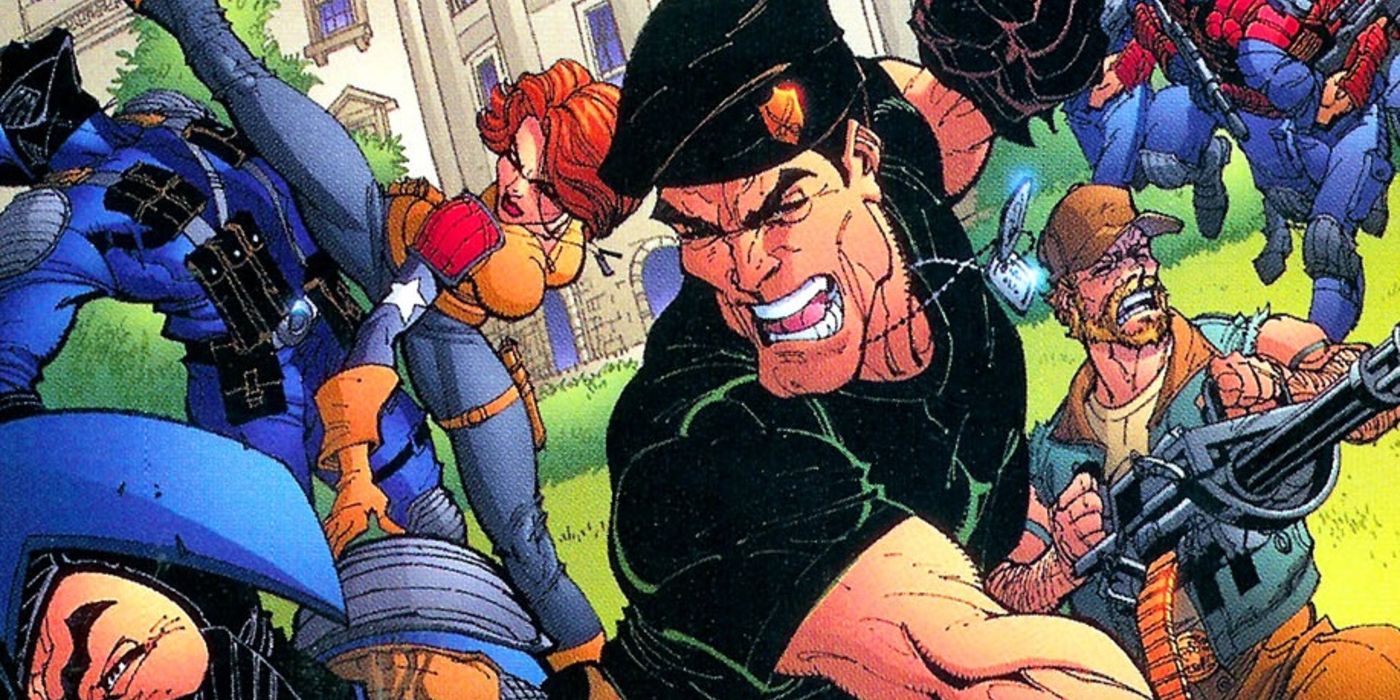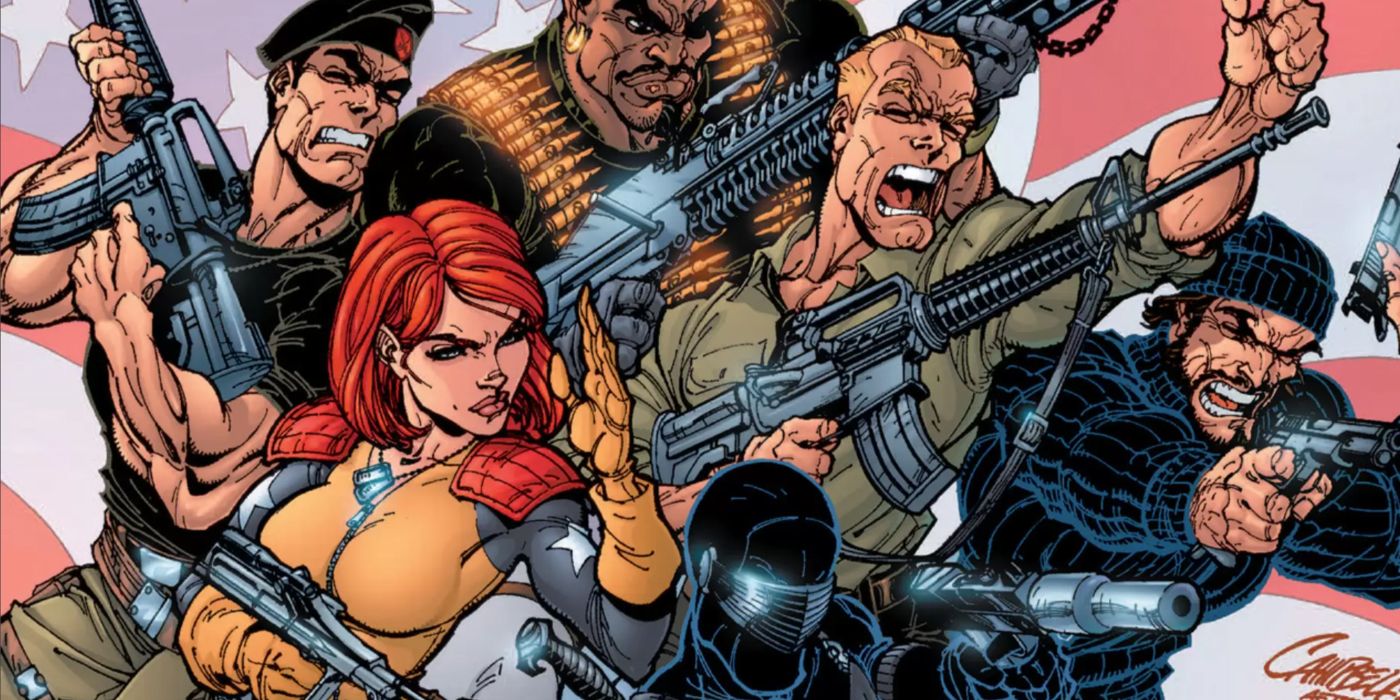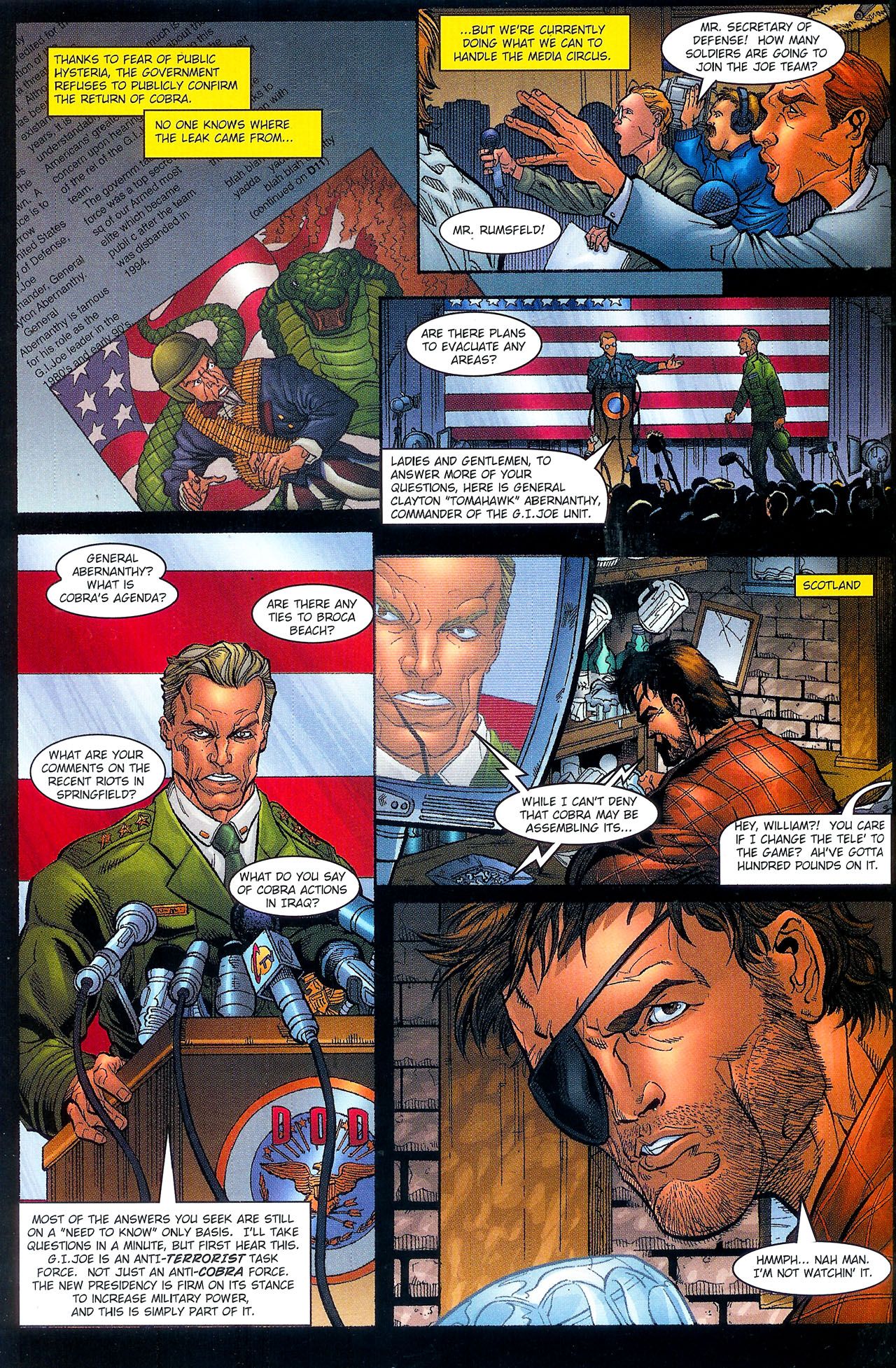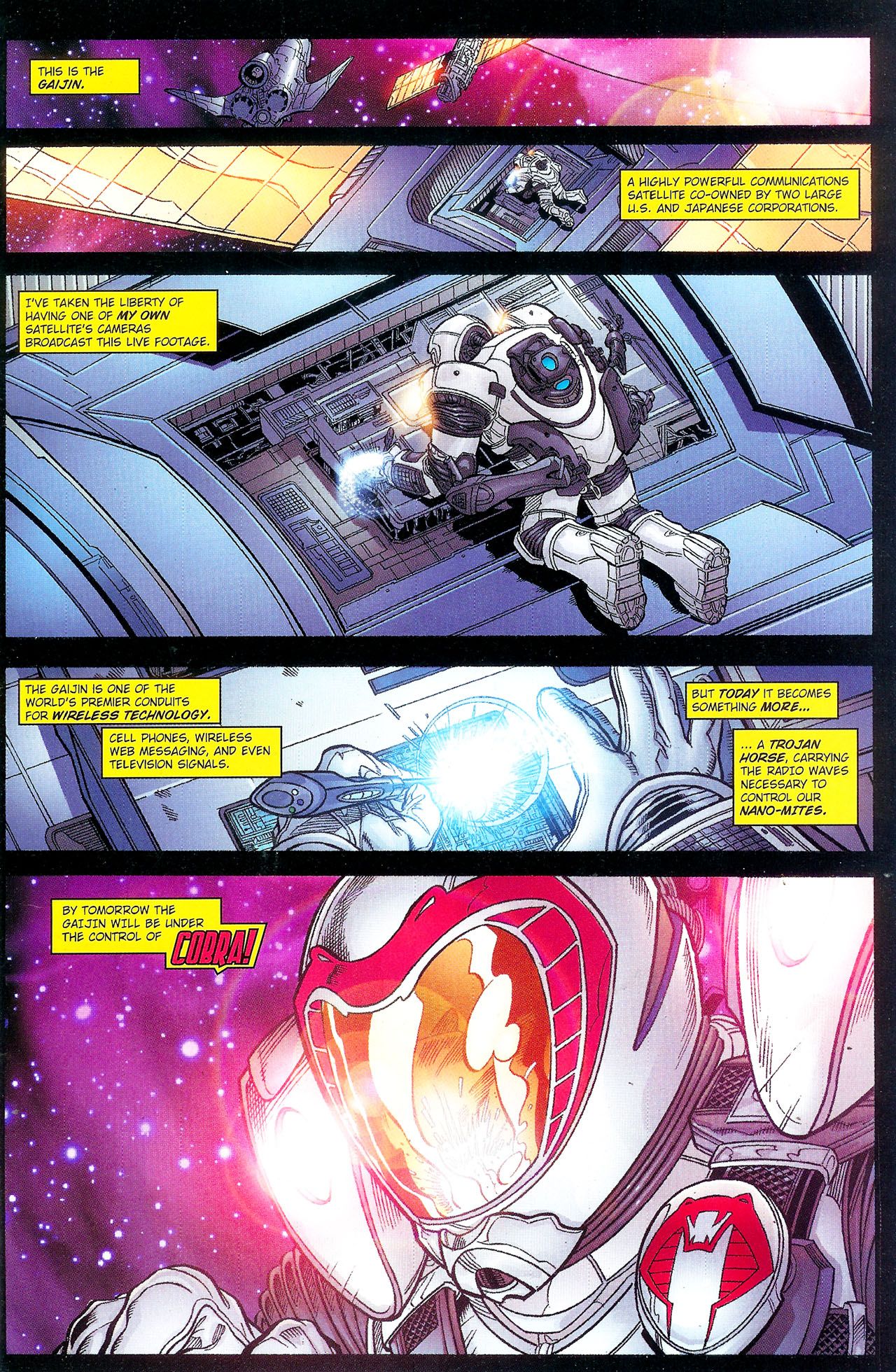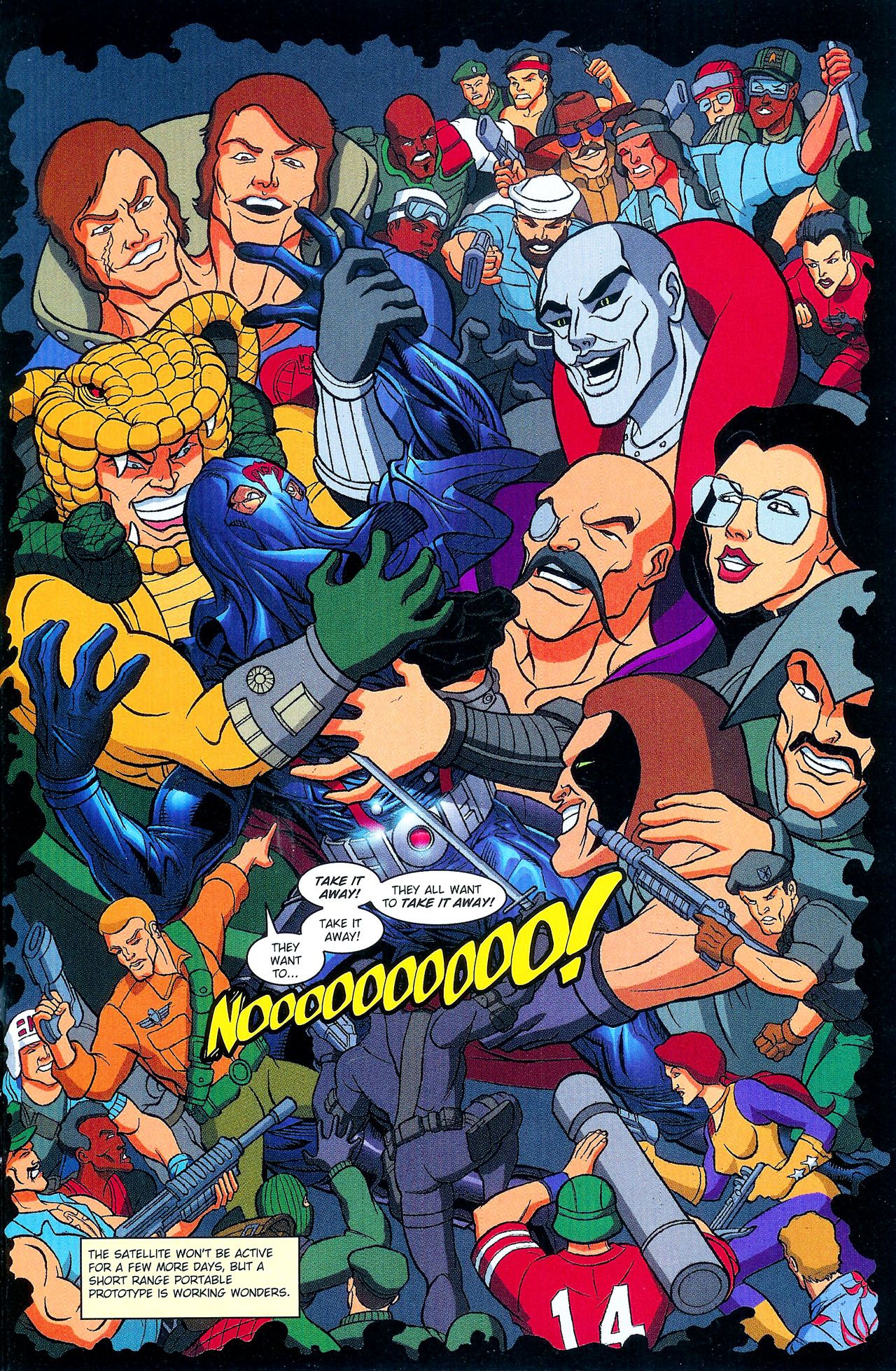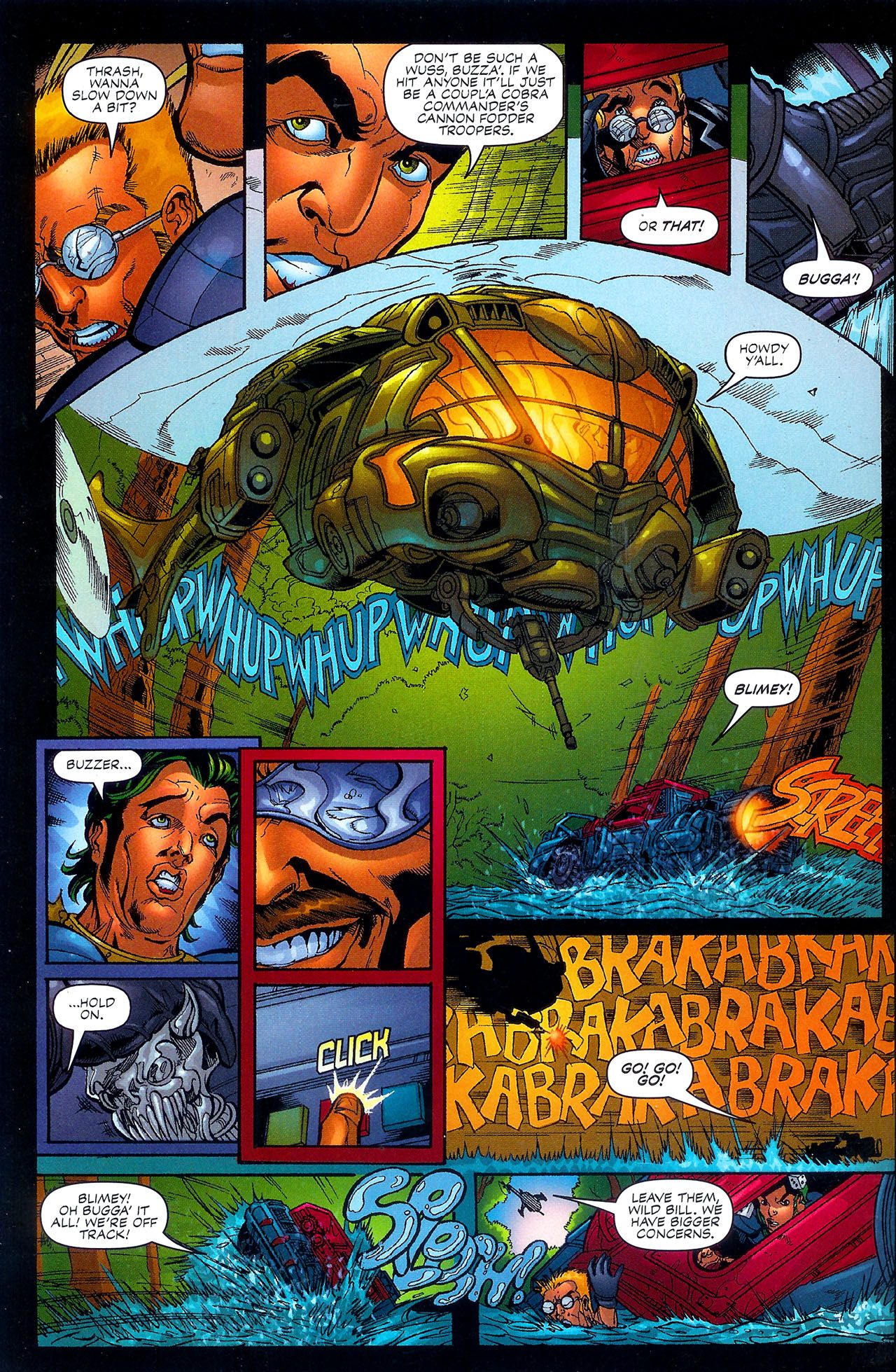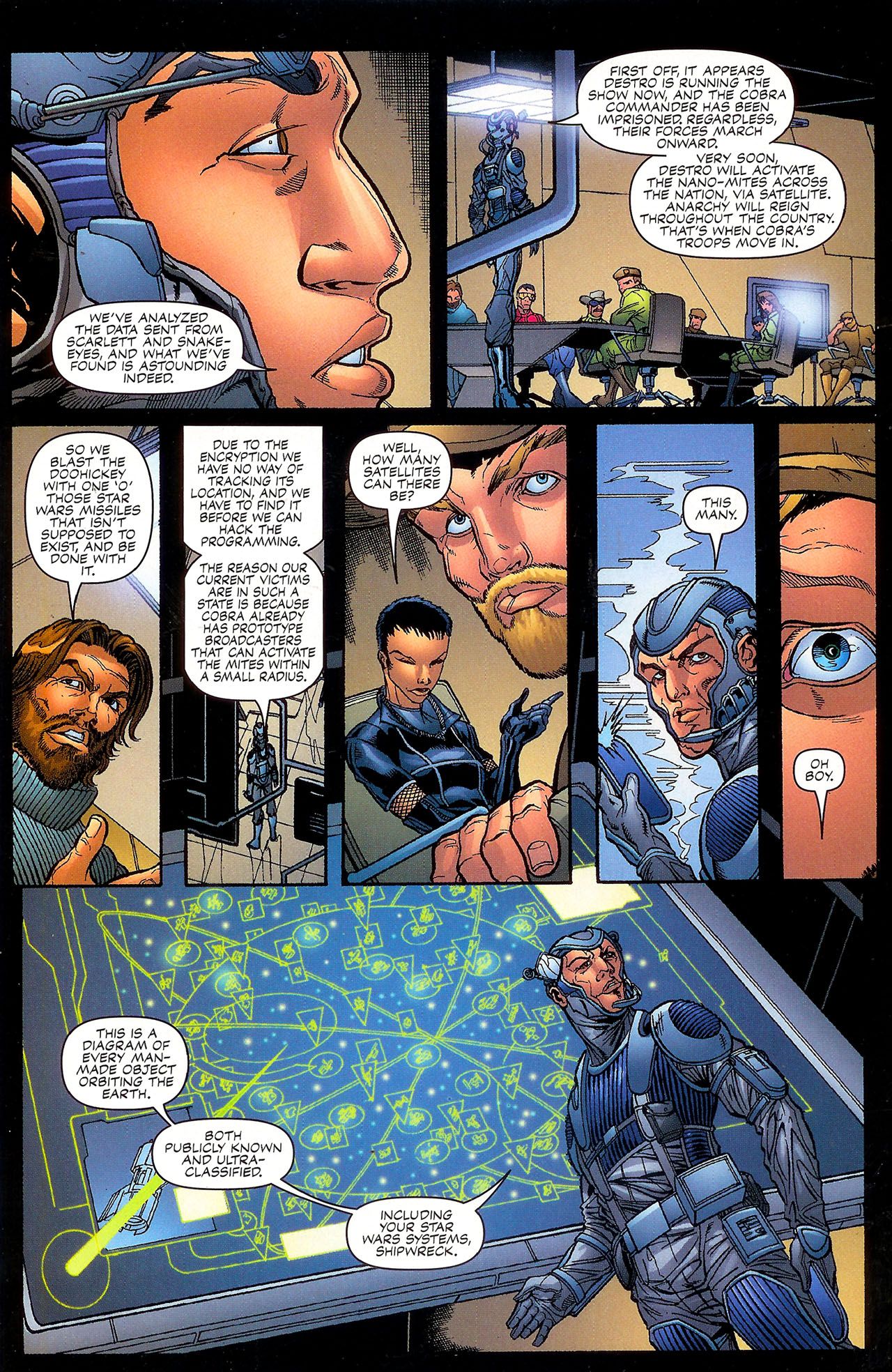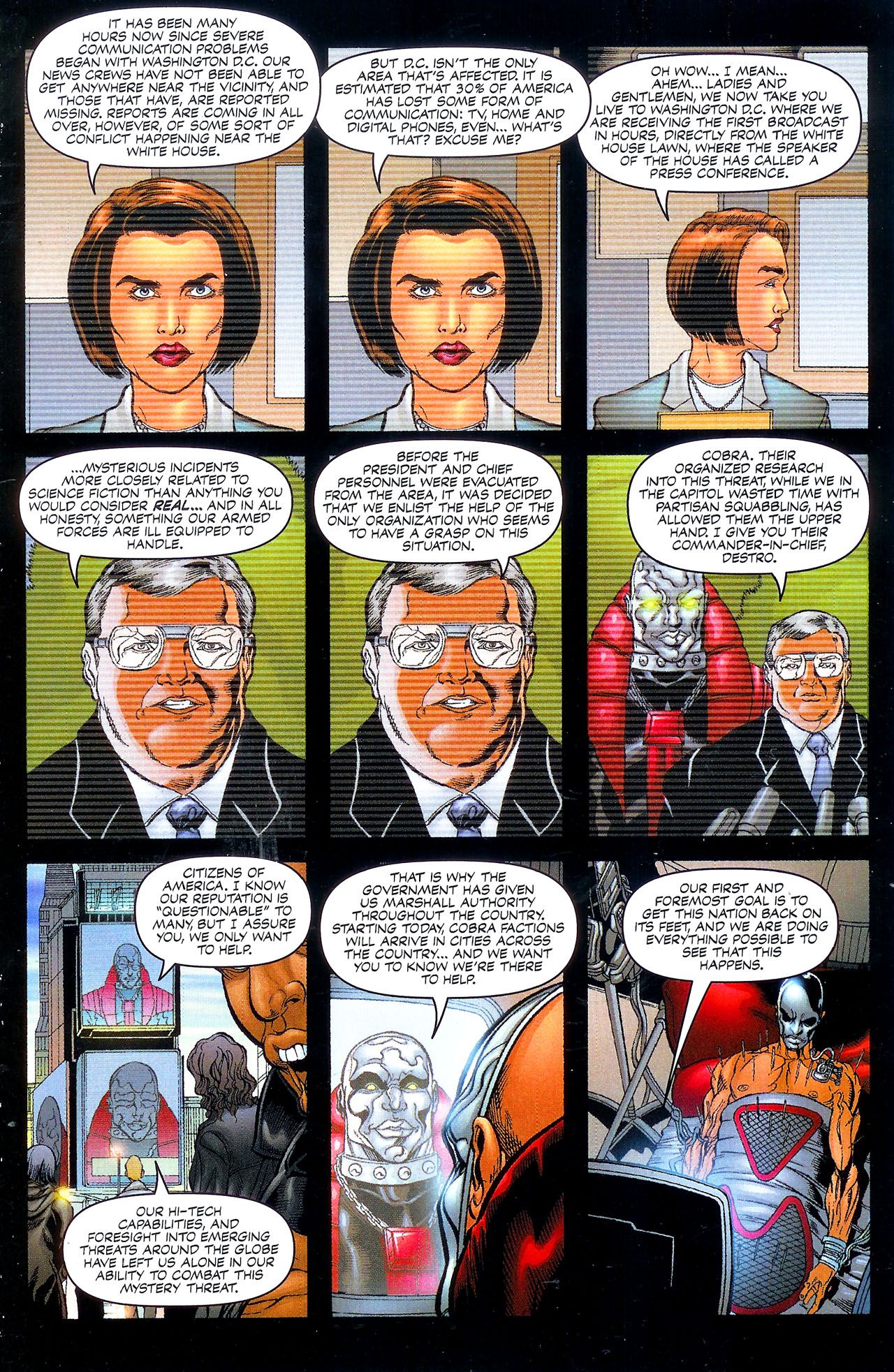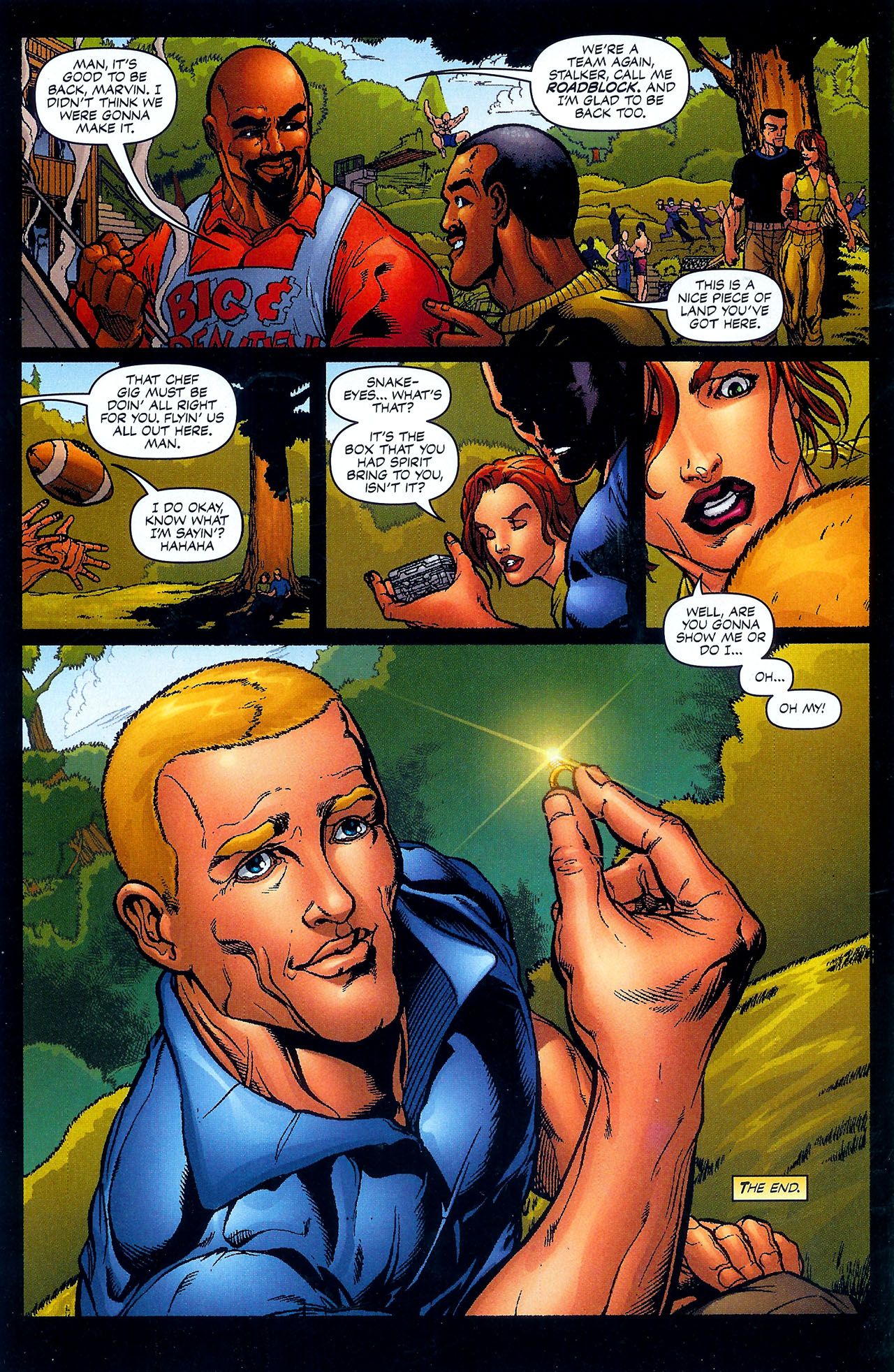Welcome to Nostalgia Snake's third installment, a look at the early 2000s revival of popular 1980s properties. This week, we're wrapping up our look at the return of G. I. Joe, which happened to arrive in one of the strangest times in American history. And if you have any suggestions for the future, you can let me hear them on Twitter.
The first issue of the revamped G. I. Joe: A Real American Hero (produced by Devil's Due and published through Image) went on sale on September 12, 2001. Assembling the issue, the creators had no way of knowing their comic about "America's daring, highly-trained special mission force" would debut a day after the deadliest terrorist attack in American history. It wasn't even certain how much of an audience existed for the book; G. I. Joe's popularity had peaked over ten years earlier, and -- aside from cover artist J. Scott Campbell -- there were no "name" talents attached to the book. An attempt to revive the title with its original writer, Larry Hama, and veteran Marvel artist Ron Lim had flamed out two years earlier before the first issue was even completed.
Orders of the revamped G. I. Joe were outrageously high, however. So high, Devil's Due immediately announced that Joshua Blaylock and Steven Kurth's four-issue miniseries was actually ongoing and that spinoffs were coming. The question of how to portray G. I. Joe in a post-9/11 world was a challenge to the creators, but the renewed sense of patriotism following the attacks combined with growing nostalgia for 1980s properties enabled the book's opening arc to maintain the first issue's momentum.
After calling the team back into active status in the debut issue, "Reinstated!" continues with an issue dedicated to the victims of 9/11, and an over-the-top, action-packed story featuring a cartoonish version of terrorism unrecognizable from what Americans had just endured. But few seemed to mind; the issue was likely close to completion when the attack occurred, and no one was quite certain how to address the tragedy in entertainment at the time, anyway. If anything, a somber story grounded in realism might've been perceived as tasteless.
A few acknowledgments of the world post-9/11 are here, such as referencing the actual identities of politicians and the Secretary of Defense. General Hawk (now called "Tomahawk" due to Hasbro losing the rights to the name for a few years) gives the kind of press conference the country grew accustomed to, following the attacks. The mere existence of the cartoonish Cobra, complete with a roster of fan-favorite characters, in the days of actual terrorists responsible for killing innocent people, is a thorny issue the comic quickly ignores.
Moving the plot along, writer Josh Blaylock and penciler Steve Kurth establish the Gaijin satellite, soon to be overtaken by Cobra and used in its plot to infect its enemies with nano-mites.
Though Kurth still struggles with human faces, the second issue's opening page displays his knack for drawing technology.
New leader Destro boasts to Zartan, Tomax, Xamot, Major Bludd, Dr. Mindbender and the Baroness that he's taken Cobra Commander's place, and won't hesitate to also infect any dissenters with the nano-mites. When we check in on the Commander, he's been driven mad by the nano-mites.
In fact, he's so detached from reality that he's experiencing visions of the 1980s G. I. Joe cartoon from Sunbow Productions, explicitly acknowledging the TV show that the initial comics series essentially ignored.
The Joes, meanwhile, are introduced to a new recruit of "greenshirt" rookies they're expected to train before attacking the revived threat of Cobra. The new guys aren't established characters from the Marvel series or toyline, so it's not hard to guess their inevitable fate when going against Cobra. Snake-Eyes and Scarlett have easier fates, merely being captured by the Dreadnoks.
While attempting to apprehend Major Bludd, a cadre of Joe troops are infected with nano-mites, taking several characters off the board for much of the story. Meanwhile, Zartan (who believes the nano-mites can cure his skin disease) and his teen daughter Zanya clear squatters out of an old Dreadnok hideout. But this isn't the only multi-generational aspect of the arc.
Snake Eyes' pupil, and estranged son of Cobra Commander, Billy is brought back into the fold to aid in the rescue of Scarlett and Snake Eyes. And the confident Destro of the introductory issue is revealed to actually be a new creation: Alexander, the illegitimate son of the arms-merchant everyone loved in the 1980s. In place of the Baroness, he's joined by another new creation for the series, Mistress Armada. Finally, the Joes feature new members specially crafted for the early 2000s -- tech experts Daemon and Firewall. (The letter column soon acknowledges fans are "divided" on these new characters.) It's interesting that a title reliant on nostalgia also plays with the theme of generations inevitably passing.
Other attempts at updating the franchise include a new uniform for Spirit (a sleek black bodysuit in place of the outfit built around stereotypical Native American influences) and a total redesign of Wild Bill's prized helicopter, the Dragonfly. Now, it's truly bug-like... and very 2001.
And Mainframe, initially portrayed as a gruff Vietnam vet who just happened to have a knack for computing, is redesigned as something you'd see in one of those Matrix videogame spinoffs.
In the final issue of the arc, we see Cobra succeed in infecting large portions of the public with their nano-mites. There is a clever twist here, as Cobra appears as a relief organization, offering aid in the midst of the chaos. The kind of relief the American government can't offer because Cobra's crippled its operations with those aforementioned nano-mites.
Congress acts to give Cobra martial authority over America; later iterations of Joe will feature a similar plot point, such as Larry Hama's revival of the original continuity for IDW and the second live-action G. I. Joe film. (Admittedly, it's unlikely either knew about this story arc. The swerve of casting Cobra as America's security force is just one of those ideas you'd expect to eventually see.) The title once again utilizes real-life figures to announce this, like Speaker of the United States House of Representatives and future convicted felon Dennis Hastert.
Luckily, Mainframe and Firewall discern Gaijin as the source of Cobra's attack, thanks to an anonymous tip placed by Cobra Commander. The nano-mites are hacked and reprogrammed to heal their victims before the Joes and Cobras engage in a heated battle on the front lawn of the White House.
Following their victory, the Joes enjoy a barbeque. (Although the once-popular Joe from the '80s, Barbeque, is nowhere to be seen.) Scarlett and Snake Eyes have moved past their differences during their time in captivity, and Snake Eyes surprises her with an engagement ring.
The true surprise would the appearance of an unmasked, and scar-free, Snake Eyes, but let's assume that's the rubber mask he used to wear back in the Larry Hama issues. Although, even in the rubber mask, there was always an effort to cover at least some of this "face." Having him appear like this is truly odd, from the perspective of a longtime reader.
Truthfully, the book feels aimed more towards fans with general nostalgia for the property and not the dedicated fanbase cultivated over the extensive run of the initial Marvel series. The structure of the story is reminiscent of the animated series' multi-part season openers, with the team split up across various locations, new characters casually popping up, and the heroes facing certain defeat before a miraculous event saves the day. It's not trying to be deep, it's pure entertainment, but G. I. Joe at its best is capable of more. It's easy to imagine Larry Hama writing a post-9/11 story that touches on patriotism, service and the human cost of war.
What is impressive is just what Devil's Due was able to accomplish as such a tiny entity, outperforming most Marvel and DC titles of the era. Not only did their G. I. Joe re-establish an audience for the property, prompting Marvel to finally reprint the earlier Joe comics, but it set the stage for a full revival of 1980s favorites. In fact, Devil's Due is already boasting by Joe's second issue that it's picked up the long-dormant rights to Micronauts.
Hey, my latest paranormal novel Love is Dead(ly) is now on sale! Find out what happens when a cocky ghost hunter finds himself trapped in the afterlife with the ghosts he's been chasing!
0 Links

